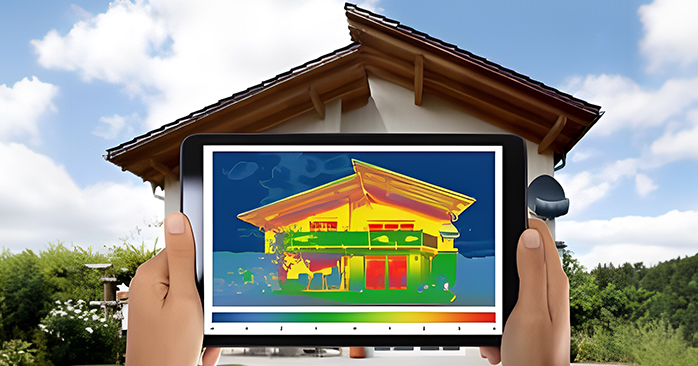Introduction
Thermal imaging technology, a remarkable tool in modern diagnostics, captures heat emitted from objects and translates it into visual data. A common question arises: Can thermal cameras actually see through walls? This blog aims to delve into this intriguing query, exploring the capabilities and limitations of thermal imaging with walls. We’ll unpack the science behind thermal cameras, illustrate what they can and cannot detect, and highlight their practical applications, especially in building inspections. Understanding the true potential of thermal cameras helps set realistic expectations and fully leverage their benefits in various applications.
Understanding Thermal Imaging
Thermal cameras operate on a simple yet fascinating principle: they detect and visualize heat emitted by objects, known as heat signatures. Unlike standard cameras that capture light visible to the human eye, thermal cameras focus on the infrared spectrum, which is invisible to us. Every object emits infrared radiation as a function of its temperature, and these cameras translate this radiation into a visible heat map.
This technology doesn’t just show us an image; it provides a temperature profile. Different colors represent different temperatures, creating a visual spectrum of heat intensity. This feature is handy in identifying temperature variations that indicate heat loss, overheating components, or hidden objects in various environments. However, it’s crucial to understand that thermal imaging cameras capture surface heat and cannot “see” through solid objects like walls. They reveal the heat on the wall’s surface, not what’s behind it.
Limitations of Thermal Cameras
While thermal cameras are powerful tools for visualizing heat, it’s essential to understand their limitations. A common misconception is that they can see through walls. Still, their capability is confined to reading surface temperatures, not what lies beyond solid barriers. Below are some limitations of thermal cameras:
Misconception about Seeing Through Walls
It’s a common belief that thermal cameras can see through walls. However, this needs to be clarified. Unlike X-ray vision, thermal cameras are not designed to penetrate or visualize objects behind solid barriers like walls.
Detecting Surface Temperatures, Not Beyond
Thermal cameras are skilled in detecting and displaying surface temperatures. When pointed at a wall, they provide data on its temperature, not what lies behind it. If there’s a heat source within the wall, it might affect the surface temperature. Still, the camera itself cannot directly ‘see’ or image objects or spaces behind the wall.
By understanding these limitations, users can better apply thermal imaging technology for its intended purpose – analyzing surface heat patterns rather than attempting to peer through solid structures.
What Thermal Cameras Can Reveal About Walls
While thermal cameras cannot see through walls, they are incredibly effective at revealing certain conditions affecting walls. Here’s how they make a difference:
Detecting Insulation Gaps
Thermal cameras are adept at identifying insulation problems in walls. For example, areas with insufficient insulation will appear differently on a thermal image due to the temperature variation. This feature is especially useful in energy audits, where pinpointing insulation gaps can significantly improve energy efficiency.
Uncovering Water Leaks
Water leaks inside walls can also be detected. Since water changes the thermal conductivity of a material, a wet area will have a different thermal signature. This ability allows for early detection of leaks, often before they cause visible damage, saving time and money in repairs.
Highlighting Heat Loss
Heat loss through walls is another issue that thermal cameras can detect. Areas where heat is escaping will show up clearly, indicating spots needing additional insulation or repair. This is particularly valuable in colder climates, where heat loss can lead to increased heating costs.
These real-world applications demonstrate the practicality of thermal cameras in building maintenance and energy management. By interpreting the thermal signatures on walls, they provide valuable insights that are not readily visible to the naked eye.
Comparing Thermal Cameras with Other Technologies
Regarding imaging and analysis tools, thermal cameras stand distinct. Still, it’s insightful to compare them with other technologies like X-rays and ground-penetrating radar (GPR). Each has its unique capabilities and limitations.
Thermal Cameras vs. X-rays
- Thermal Cameras: These devices excel in detecting and visualizing surface temperature variations. They are non-invasive and can be used to inspect electrical systems, find insulation gaps, or identify moisture issues. However, they cannot see through objects.
- X-rays: X-ray technology penetrates objects to provide internal images, commonly used in medical diagnostics and security. Unlike thermal cameras, X-rays can reveal what’s inside a structure but involve radiation exposure and typically require controlled environments for safe operation.
Thermal Cameras vs. Ground-Penetrating Radar
- Thermal Cameras: These are surface-focused, excellent for immediate surface temperature analysis but limited to what’s visible.
- Ground-Penetrating Radar (GPR): GPR is used for subsurface exploration, like detecting underground utilities or archaeological artifacts. It can penetrate various materials like soil, concrete, and rock, offering a view beneath the surface. However, GPR can be complex to interpret and often requires specialized expertise.
In wrapping up, thermal cameras are vital in building analysis, providing crucial insights into heat variances essential for maintenance and energy efficiency. As technology advances, these tools become more sophisticated, offering higher resolution, AI-enhanced analysis, and greater user accessibility. For professionals and enthusiasts alike, thermal cameras ensure optimal building health and energy management. Accurate Sensing Technologies is your ideal destination if you’re looking for precise and advanced temperature measurement solutions.









